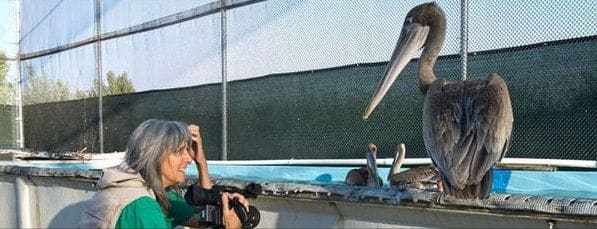Eye For Film >> Movies >> Pelican Dreams (2014) Film Review
Pelican Dreams
Reviewed by: Anne-Katrin Titze

On December 15, 2011, The New York Times published an article Fishing Lines, Deadly When Discarded, Pose Threat to Birds in City Parks, raising awareness of what actions need to be taken to protect urban wildlife.
Judy Irving's insightful Pelican Dreams should not be missed. Her latest film cleverly takes up the urgent challenge by bringing to light the necessity of caring for our seabirds.
A shimmering orange-red reflection on the water turns out to come from below San Francisco's Golden Gate Bridge, the place where we encounter one of her stars. To everyone's surprise, a California brown pelican has landed on the roadway. Avoiding the traffic, it is captured by an inexperienced yet determined tow truck driver, who throws a towel over the disorientated seabird's head.
Intrigued, Irving decides to follow the journey and lands herself at the San Francisco Bay Oiled Wildlife Care and Education Center, run by wildlife rehabilitator Monte Merrick with his wife Laura Corsiglia. We hear "What's going on with your eyes, sweetie pie?" as he examines the pelican. His tone is that of someone deeply concerned with his patient's well-being who is also fully aware that he is dealing with a wild animal to hopefully be re-released at some point.
Gigi, as in Golden Gate, officially identified as "Pink 193" by her temporary ankle bracelet, is dehydrated and very thin. Names are not common in wildlife rehabilitation, but of course, the name sticks, as she joins dozens of injured birds at the facility's training pool. "They initiate eye contact," Merrick explains, and the difficulties of not bonding become all too obvious when we see him easily identify Gigi for Irving when she returns to check on her. Irving skillfully asks questions. How do you distinguish a juvenile from an adult bird? What are the reasons for the water birds' incessant preening?
The filmmaker briefly recalls dreams of herself flying. Instead of transforming those into a Michael Keaton fantasy sequence, as Alejandro G. Iñárritu does in Birdman Or The Unexpected Virtue Of Ignorance, she takes us 40 miles off the California coast to the Channel Island of Santa Barbara where we get to watch brown pelicans breed, hatch, feed, battle extreme sibling rivalry, and if successful, learn to fly.
Seabird ecologist Laurie Harvey, among other tasks, restores the island's habitat by growing native plants so the pelicans can nest. She guides us through their development. Hatched in April, in July a gang of juveniles, figure out how to fly, dive and fish the ocean.
The young grow rapidly and watching how the flapping of their large yet untrained wings shifts from clumsy to majestic, makes you think about the mysteries not only of flying but of learning in general. Food is sparse and the perfect diving technique with a half twist needs practice. Like most young animals, pelicans learn survival while playing.
We are introduced to three more injured brown pelicans, Morro, Toro and Choro, who are with wildlife rehabilitator Dani Nicholson and her husband Bill in Central California near Morro Bay. After Morro's two pelican companions are fit enough to fly off, we see him bond with his own mirror image and Festus, a feisty duck who now becomes his backyard pal.
A 30 million year-old fossil of a beak speaks of their long history, one that almost ended in the Sixties, when the brown pelican was added to the Endangered Species List. A clip from the 1969 film A Wonderful Bird WAS The Pelican has Richard Risebrough explain the threat of extinction due to reproductive failure which was caused by extremely high levels of DDT in the water. DDT was subsequently banned in the early Seventies, but other problems remain.
In 2009, the brown pelican was no longer on the Endangered Species List. Climate change, overfishing and pollution still are concerns. Migration patterns are shifting - warmer temperatures up the Pacific Coast near the border of Washington and Oregon, kept pelicans from flying South in due time, killing many in an early snowstorm. Oil spills and the fishing industry can become a disaster for wildlife on a large scale. Individual, careless anglers do their own harm, even in city parks.
Judy Irving, who documented The Wild Parrots Of Telegraph Hill, hits all the right chords in Pelican Dreams, her latest exploration into our avian world - without even one reference to Bodega Bay.
Reviewed on: 16 Oct 2014














